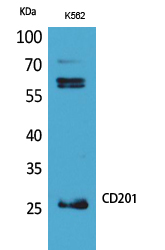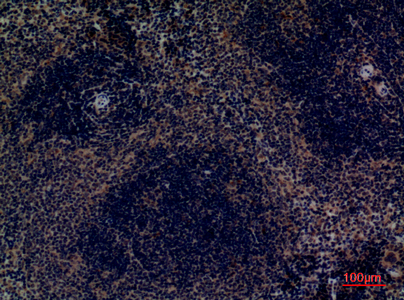CD201 Polyclonal Antibody
- Catalog No.:YT5287
- Applications:WB;IHC;IF;ELISA
- Reactivity:Human;Mouse;Rat
- Target:
- CD201
- Fields:
- >>Complement and coagulation cascades
- Gene Name:
- PROCR
- Protein Name:
- Endothelial protein C receptor
- Human Gene Id:
- 10544
- Human Swiss Prot No:
- Q9UNN8
- Mouse Gene Id:
- 19124
- Mouse Swiss Prot No:
- Q64695
- Rat Gene Id:
- 362248
- Rat Swiss Prot No:
- Q4V8I1
- Immunogen:
- Synthesized peptide derived from Endothelial protein C receptor at AA range: 141-190
- Specificity:
- CD201 Polyclonal Antibody detects endogenous levels of CD201 protein.
- Formulation:
- Liquid in PBS containing 50% glycerol, 0.5% BSA and 0.02% sodium azide.
- Source:
- Polyclonal, Rabbit,IgG
- Dilution:
- WB 1:500 - 1:2000. IHC: 1:100-300 ELISA: 1:20000.. IF 1:50-200
- Purification:
- The antibody was affinity-purified from rabbit antiserum by affinity-chromatography using epitope-specific immunogen.
- Concentration:
- 1 mg/ml
- Storage Stability:
- -15°C to -25°C/1 year(Do not lower than -25°C)
- Other Name:
- PROCR;EPCR;Endothelial protein C receptor;Activated protein C receptor;APC receptor;Endothelial cell protein C receptor;CD201
- Observed Band(KD):
- 26kD
- Background:
- The protein encoded by this gene is a receptor for activated protein C, a serine protease activated by and involved in the blood coagulation pathway. The encoded protein is an N-glycosylated type I membrane protein that enhances the activation of protein C. Mutations in this gene have been associated with venous thromboembolism and myocardial infarction, as well as with late fetal loss during pregnancy. The encoded protein may also play a role in malarial infection and has been associated with cancer. [provided by RefSeq, Jul 2013],
- Function:
- function:Binds activated protein C. Enhances protein C activation by the thrombin-thrombomodulin complex; plays a role in the protein C pathway controlling blood coagulation.,PTM:A soluble form exists; probably released by a metalloprotease. Seems to have the same activity as the membrane-bound form.,PTM:N-glycosylated.,tissue specificity:Expressed strongly in the endothelial cells of arteries and veins in heart and lung, less intensely in capillaries in the lung and skin, and not at all in the endothelium of small vessels of the liver and kidney.,
- Subcellular Location:
- Membrane; Single-pass type I membrane protein.
- Expression:
- Expressed strongly in the endothelial cells of arteries and veins in heart and lung, less intensely in capillaries in the lung and skin, and not at all in the endothelium of small vessels of the liver and kidney.
- June 19-2018
- WESTERN IMMUNOBLOTTING PROTOCOL
- June 19-2018
- IMMUNOHISTOCHEMISTRY-PARAFFIN PROTOCOL
- June 19-2018
- IMMUNOFLUORESCENCE PROTOCOL
- September 08-2020
- FLOW-CYTOMEYRT-PROTOCOL
- May 20-2022
- Cell-Based ELISA│解您多样本WB检测之困扰
- July 13-2018
- CELL-BASED-ELISA-PROTOCOL-FOR-ACETYL-PROTEIN
- July 13-2018
- CELL-BASED-ELISA-PROTOCOL-FOR-PHOSPHO-PROTEIN
- July 13-2018
- Antibody-FAQs
- Products Images

- Western Blot analysis of K562 cells using CD201 Polyclonal Antibody. Antibody was diluted at 1:500. Secondary antibody(catalog#:RS0002) was diluted at 1:20000

- Western blot analysis of Rat-barin lysis using CD201 antibody. Antibody was diluted at 1:500. Secondary antibody(catalog#:RS0002) was diluted at 1:20000
.jpg)
- Immunohistochemical analysis of paraffin-embedded human-spleen, antibody was diluted at 1:100

- Immunohistochemical analysis of paraffin-embedded mouse-spleen, antibody was diluted at 1:100



